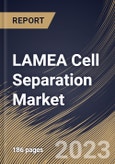The rapid developments in cell-based technology, such as higher purity yield, shorter cell isolation times, an increase in government initiatives to enhance cell-based technology, cost-effectiveness, and the well-developed healthcare infrastructure in developing nations, are expected to create significant growth opportunities for the market during the forecast period.
Cell separation methods and products have expanded along with the prevalence of HIV/AIDS. This is due to the technique's ability to give medical professionals effective HIV-detecting abilities. During HIV detection, cell separators are frequently employed to separate viruses and identify target cells. Increasing demand for personalized medication raises the need to develop cell lines to produce customized drugs. This is driving up demand in the market.
Cellseparation-related technological developments are anticipated to accelerate the market's expansion. As a result of these developments, cell isolation goods such as equipment and kits may be used more frequently and at lower costs. For instance, in March 2022, Thermo Fisher Scientific unveiled the new, completely customizable Gibco CTS Xenon Electroporation System, which enables the research and development of cell therapies on a massive scale for clinical use. The Gibco CTS Xenon Electroporation System enhances the portfolio of end-to-end cell treatment solutions offered by Thermo Fisher Scientific. Therefore, during the projected period, such breakthroughs and product introductions are anticipated to fuel market expansion.
When compared to Hodgkin lymphoma (HL), non-Hodgkin lymphoma (NHL) tends to occur less frequently throughout the majority of the Middle East. Population-based cancer registries exist in Saudi Arabia and Jordan that satisfy the requirements for data submission to the International Association for Research on Cancer (IARC). According to these registries, the majority of HL cases in the Middle East were discovered in people under the age of 40 (78% in Jordan, 78% in Saudi Arabia, and 73% in Iraq). Though, the prevalence of cancer is increasing rapidly across the region and the market is thus expected to grow in the LAMEA.
The Brazil market dominated the LAMEA Cell Separation Market by Country in 2022 and would continue to be a dominant market till 2030; thereby, achieving a market value of $281.1 million by 2030. The Argentina market is showcasing a CAGR of 13.1% during (2023-2030). Additionally, The UAE market would register a CAGR of 12.1% during (2023-2030).
Based on Product Type, the market is segmented into Consumables (Reagents, Kits, Media, & Sera, Disposables, and Beads), and Instruments (Centrifuges, Flow Cytometers, Filtration Systems, and Magnetic-activated Cell Separator Systems). Based on End-Use, the market is segmented into Biotechnology & Biopharmaceutical Companies, Research Laboratories & Institutes, Hospitals & Diagnostic Laboratories, and Cell Banks. Based on Cells Type, the market is segmented into Animal Cell, and Human Cell. Based on Technique, the market is segmented into Centrifugation, Surface Marker, and Filtration. Based on Application, the market is segmented into Biomolecule Isolation, Cancer Research, Stem Cell Research, Tissue Regeneration, In Vitro Diagnostics, and Therapeutics. Based on countries, the market is segmented into Brazil, Argentina, UAE, Saudi Arabia, South Africa, Nigeria, and Rest of LAMEA.
The market research report covers the analysis of key stake holders of the market. Key companies profiled in the report include Thermo Fisher Scientific, Inc., Becton, Dickinson and Company, Merck KGaA, Danaher Corporation, Agilent Technologies, Inc., Bio-Rad Laboratories, Inc., Corning Incorporated, Terumo Corporation, STEMCELL Technologies, Inc. and Akadeum Life Sciences, Inc.
Scope of the Study
By Product Type
- Consumables
- Reagents, Kits, Media, & Sera
- Disposables
- Beads
- Instruments
- Centrifuges
- Flow Cytometers
- Filtration Systems
- Magnetic-activated Cell Separator Systems
By End-Use
- Biotechnology & Biopharmaceutical Companies
- Research Laboratories & Institutes
- Hospitals & Diagnostic Laboratories
- Cell Banks
By Cells Type
- Animal Cell
- Human Cell
By Technique
- Centrifugation
- Surface Marker
- Filtration
By Application
- Biomolecule Isolation
- Cancer Research
- Stem Cell Research
- Tissue Regeneration
- In Vitro Diagnostics
- Therapeutics
By Country
- Brazil
- Argentina
- UAE
- Saudi Arabia
- South Africa
- Nigeria
- Rest of LAMEA
Key Market Players
List of Companies Profiled in the Report:
- Thermo Fisher Scientific, Inc.
- Becton, Dickinson and Company
- Merck KGaA
- Danaher Corporation
- Agilent Technologies, Inc.
- Bio-Rad Laboratories, Inc.
- Corning Incorporated
- Terumo Corporation
- STEMCELL Technologies, Inc.
- Akadeum Life Sciences, Inc.
Unique Offerings
- Exhaustive coverage
- The highest number of Market tables and figures
- Subscription-based model available
- Guaranteed best price
- Assured post sales research support with 10% customization free
Table of Contents
Companies Mentioned
- Thermo Fisher Scientific, Inc.
- Becton, Dickinson and Company
- Merck KGaA
- Danaher Corporation
- Agilent Technologies, Inc.
- Bio-Rad Laboratories, Inc.
- Corning Incorporated
- Terumo Corporation
- STEMCELL Technologies, Inc.
- Akadeum Life Sciences, Inc.
Methodology

LOADING...








